Ground covers are among the most practical plants in the garden designer’s palette. They give the most bang for the buck by colonizing large areas through plantings of tiny, inexpensive plugs. There are many options for difficult-to-plant areas, like dense shade and dry slopes.
There are hundreds to choose from in every color and texture imaginable, but only a handful resist browsing by deer. A large percentage of the most deer-resistant ground covers are highly invasive species, but here is a short list of those that can be used responsibly in the landscape.
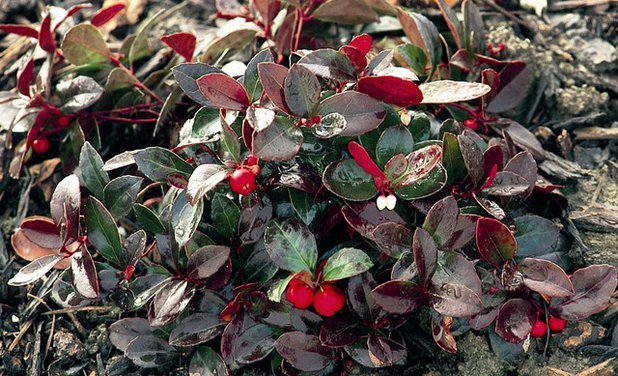
Monrovia
1. Eastern Teaberry(
Gaultheria procumbens)
Eastern teaberry, also called wintergreen, is native to cold-weather climates of the eastern U.S., where it forms extensive mats in the forest. It has dainty urn-shaped flowers in spring followed by red berries, and its evergreen foliage is tinged with bronze in the fall. Eastern teaberry needs rich, acidic soil and is a good choice for growing around azaleas, hydrangeas and rhododendrons.
In the western U.S., plant the native relative known as salal (
G. shallon). This variety has similar growing requirements but grows as a tall, upright ground cover that’s 2 to 4 feet tall and is not as cold-hardy as its eastern counterpart (only to USDA Zone 6; find your zone).
Where it will grow: Hardy to minus 40 degrees Fahrenheit, or minus 40 degrees Celsius (zones 3 to 8)
Light requirement: Full or partial shade
Water requirement: Moderate
Mature size: 6 to 12 inches tall
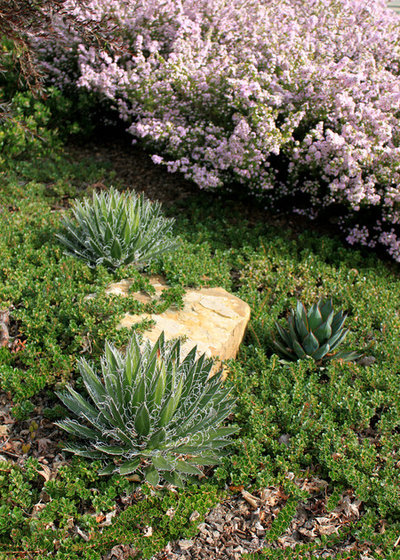
BuenoLuna Landscape Design
2. Kinnikinnick(
Arctostaphylos uva-ursi)
Most of the deer-resistant, noninvasive ground covers are shade lovers, but here is an option for sun. Kinnikinnick, also known as uva ursi or bearberry, is actually a type of manzanita that grows as a low, spreading mat. It has the same evergreen foliage and smooth reddish bark that manzanitas are known for but in a prostrate form.
It is also the only species of manzanita that grows wild outside of the West Coast. If you’re gardening on the East Coast, look for cultivars taken from the eastern subspecies, such as ‘Massachusetts’. There are also several other species of manzanita that take a ground cover form, but kinnikinnick is the lowest-growing among them.
Where it will grow: Hardy to minus 50 degrees Fahrenheit, or minus 46 degrees Celsius (USDA zones 2 to 10)
Light requirement: Full sun or light shade
Water requirement: Low
Mature size: 3 to 6 inches tall
Shown: Kinnikinnick, Queen Victoria agave (
Agave victoria-reginae) and breath of heaven (
Coleonema sp.)
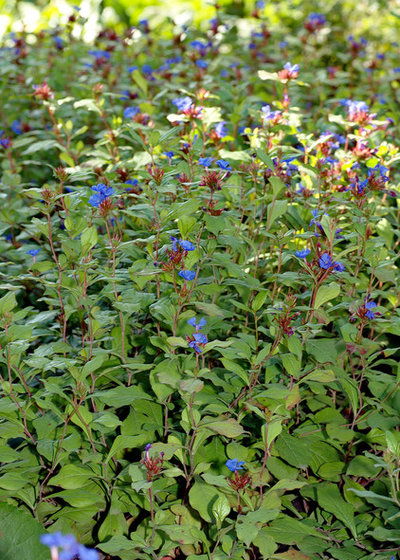 3. Dwarf Plumbago
3. Dwarf Plumbago (
Ceratostigma plumbaginoides)
Here is another option for sun. Dwarf plumbago, also known as leadwort, is a tough, well-behaved, easy-to-grow ground cover from China that forms a low mound of foliage with sky-blue flowers that appear sporadically from midsummer through fall. With the first frost of fall, the foliage becomes tinged with a burgundy color. This ground cover can spread a bit aggressively if it has lush soil and plenty of moisture, so you may need to curb its growth at times to keep it from growing into areas where it is unwanted.
Contact with dwarf plumbago may cause dermatitis on some individuals — it is best to wear gloves when pruning or handling the plant.
Where it will grow: Hardy to minus 20 degrees Fahrenheit, or minus 29 degrees Celsius (zones 5 to 9)
Light requirement: Full or partial shade
Water requirement: Low to moderate
Mature size: 6 to 12 inches tall
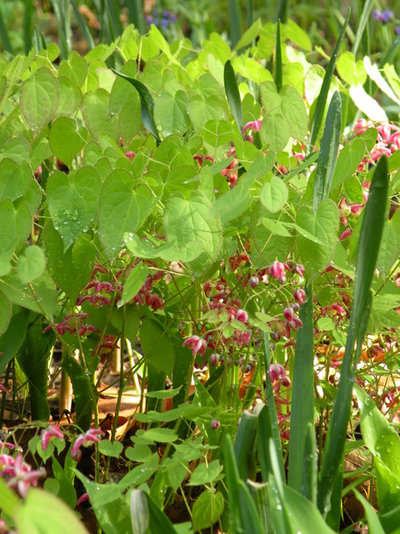
Designing Nature Inc.
4. Barrenwort (
Epimedium spp.)
Barrenwort, also known as bishop’s hat, is a tough ground cover that thrives in shady areas under large trees — an environment where the tree roots usually win out and resist the establishment of smaller plants. It spreads at a moderate rate but is not considered aggressive or invasive. The heart-shaped leaves and hat-like flowers are equally attractive.
Look for varieties like ‘Sulphureum’ (
E. x
versicolor ‘Sulphureum’), the only evergreen variety, or red barrenwort (
E. x
rubrum), which has red flowers and red-tinged foliage in early spring (pictured here).
Where it will grow: Hardy to minus 20 degrees Fahrenheit, or minus 29 degrees Celsius (zones 5 to 8)
Light requirement: Full or partial shade
Water requirement: Low to moderate
Mature size: 12 to 18 inches tall
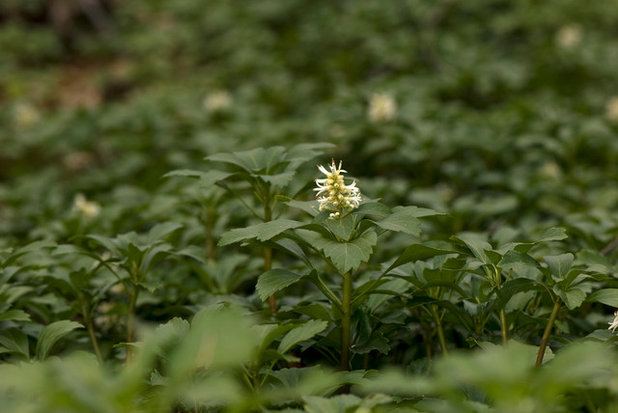
The New York Botanical Garden
5. Pachysandra (
Pachysandra spp.)
Pachysandra is a low-growing ground cover with a high degree of shade tolerance. The commonly used Japanese pachysandra (
P. terminalis), also known as Japanese spurge, is valued as one of the cold-hardiest evergreen ground covers, bringing a splash of green to fall and winter gardens in northerly climates. It can spread rather aggressively under ideal conditions and should be planted only where there is no risk of its creeping out of the garden.
The native Allegheny spurge (
P. procumbens) is a less aggressive alternative, though it is only semi-evergreen.
Caution: Pachysandra is a poisonous plant and should not be used where there is a concern that children, pets or livestock may consume it.
Where it will grow: Hardy to minus 20 degrees Fahrenheit, or minus 29 degrees Celsius (USDA zones 5 to 8; find your zone)
Light requirement: Full or partial shade
Water requirement: Moderate
Mature size: 6 to 12 inches tall
How to Use Pachysandra Responsibly in the Landscape
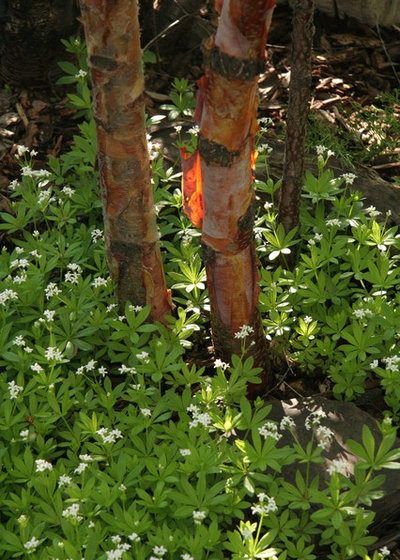
Aura Landscapers Ltd
6. Sweet Woodruff (
Galium odoratum)
A classic woodland plant native to Europe with a light, airy feel. The soft, textured foliage has long stems with a unique pattern of whorled leaves. The leaves emit a vanilla-like fragrance when dried and may be used in potpourris.
Plant sweet woodruff between stepping stones, among taller perennials or as a mass ground cover in moist, shady areas with rich soil. It will form a dense carpet in ideal conditions, which is difficult to eradicate once established, so consider the location carefully before planting.
Where it will grow: Hardy to minus 20 degrees Fahrenheit, or minus 29 degrees Celsius (zones 5 to 9)
Light requirement: Full or partial shade
Water requirement: Moderate to high
Mature size: 6 to 12 inches tall





